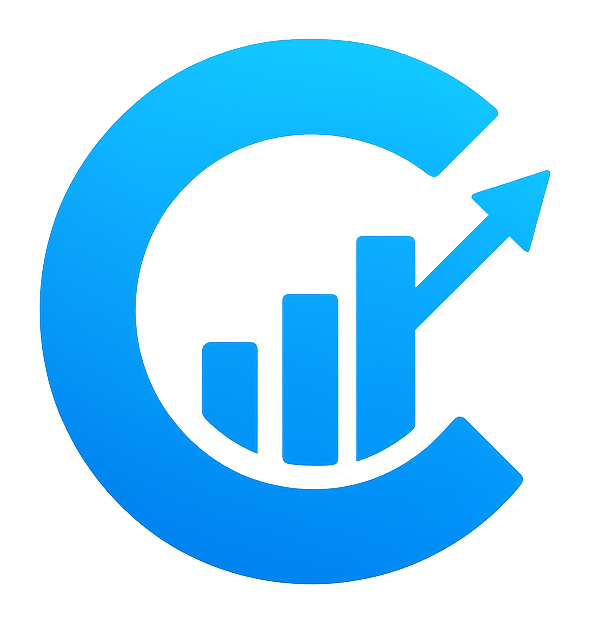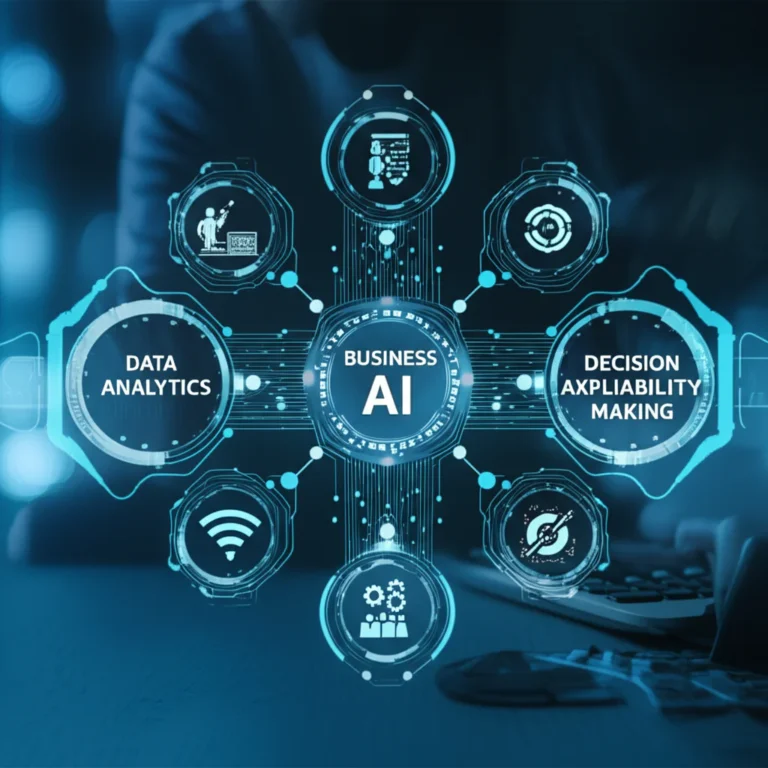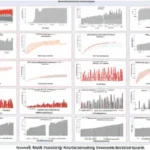Support our educational content for free when you purchase through links on our site. Learn more
Understanding AI Benchmarking for Business Applications: 12 Essential Insights (2025) 🚀
Imagine launching an AI-powered product that promises to revolutionize your business—only to discover it falters under real-world pressure. Sounds like a nightmare, right? That’s exactly what happens when companies skip the crucial step of AI benchmarking. In this comprehensive guide, we unravel the mysteries behind AI benchmarking for business applications, revealing how you can measure, compare, and optimize AI models to gain a true competitive edge.
From the evolution of benchmarking standards to hands-on tips for selecting the right tools, and from ethical considerations to real-world case studies, we cover 12 essential insights that every business leader and AI practitioner needs to know. Curious about how retail giants boost personalization or how fintech startups slash fraud losses through benchmarking? Stick around—we’ve got those stories and more.
Key Takeaways
- AI benchmarking is the foundation for informed AI adoption, helping businesses select models that truly fit their needs.
- Metrics go beyond accuracy—including latency, fairness, robustness, and energy efficiency—to paint a full performance picture.
- Choosing the right tools and datasets is critical; open-source, commercial, and cloud-native platforms each have unique strengths.
- Ethical benchmarking ensures AI fairness and compliance, safeguarding your brand and customers.
- Real-world case studies demonstrate tangible ROI from benchmarking in retail, healthcare, and finance sectors.
- Benchmarking is an ongoing process, not a one-time test, requiring cross-functional teams and continuous monitoring.
Ready to explore the best AI benchmarking tools and resources? Check out:
- MLPerf Benchmark Suite: MLPerf Official Site | Amazon Books
- Weights & Biases: Weights & Biases Official | Amazon Search
- Microsoft Azure AI Services: Azure AI
- AWS SageMaker Debugger: AWS SageMaker
Dive in and turn your AI insights into a winning business strategy!
Table of Contents
- ⚡️ Quick Tips and Facts on AI Benchmarking
- 🕰️ The Evolution of AI Performance Evaluation: A Brief History of Benchmarking
- 🤔 What is AI Benchmarking? Why Your Business Really Needs It for Strategic Advantage
- 📊 The Unsung Heroes: Key Metrics and KPIs for Robust AI Performance Evaluation
- 🛠️ Navigating the Labyrinth: Choosing the Right AI Benchmarking Tools & Platforms
- 🧪 The Art of the Test: Crafting Effective Benchmarking Scenarios for Real-World AI Applications
- 📈 From Data to Decisions: Interpreting Benchmarking Results for Maximum Business Impact and ROI
- 🚧 Common Pitfalls and How to Dodge Them in Your AI Benchmarking Journey
- 🏆 Case Studies: Real-World AI Benchmarking Success Stories (and a few cautionary tales!)
- 🤝 Building Your Dream Team: Essential Skills and Expertise for AI Benchmarking Excellence
- 🚀 The Future is Now: Emerging Trends in AI Benchmarking and What’s Next
- 🛡️ Responsible AI Benchmarking: Ensuring Ethical and Fair AI Systems for a Better Tomorrow
- ✅ Conclusion: Your Blueprint for AI Benchmarking Success
- 🔗 Recommended Links for Deeper Dives
- ❓ FAQ: Your Burning Questions About AI Benchmarking Answered
- 📚 Reference Links: The Sources We Trust
⚡️ Quick Tips and Facts on AI Benchmarking
Welcome to the thrilling world of AI benchmarking—where raw numbers meet razor-sharp insights to help your business make smarter AI investments! At ChatBench.org™, we’ve seen firsthand how benchmarking can turn a “black box” AI model into a transparent, trustworthy asset that drives competitive edge. Here are some quick nuggets to get you started:
- AI benchmarking is not just about speed or accuracy; it’s about contextual relevance—does the model perform well on your specific business tasks?
- ✅ Benchmarking frameworks like MLPerf, GLUE, and SuperGLUE are great starting points but often need customization for business-specific applications.
- ❌ Beware of benchmark overfitting—models tuned only to shine on benchmarks but fail in real-world scenarios.
- Data quality and representativeness are as important as model architecture when benchmarking. Garbage in, garbage out!
- Ethical AI benchmarking is gaining traction—measuring fairness, bias, and transparency alongside traditional metrics.
- Cloud providers like AWS, Azure, and Google Cloud offer integrated benchmarking tools that can simplify your evaluation process.
- Benchmarking is iterative—expect to revisit and refine your tests as your AI systems evolve.
For a deep dive into how AI benchmarks impact competitive AI solutions development, check out our related article on How do AI benchmarks impact the development of competitive AI solutions?.
🕰️ The Evolution of AI Performance Evaluation: A Brief History of Benchmarking
Benchmarking AI is like tracking the evolution of a sprinter from a toddler’s first steps to Olympic gold. It started humbly with rule-based systems and handcrafted heuristics in the 1980s and 1990s, where performance was measured by domain-specific tests. Then came the statistical machine learning era, introducing metrics like precision, recall, and F1 scores.
The real game-changer? Deep learning and pre-trained models in the 2010s, which brought about large-scale benchmarks like ImageNet for vision and GLUE for NLP. These benchmarks standardized evaluation, enabling apples-to-apples comparisons across models and fueling rapid innovation.
Today, benchmarking is evolving beyond accuracy and speed to include fairness, robustness, and energy efficiency, reflecting business and societal needs. For example, Microsoft Research’s work on Document AI benchmarks highlights how interdisciplinary approaches combining NLP and computer vision are advancing business document automation (source).
🤔 What is AI Benchmarking? Why Your Business Really Needs It for Strategic Advantage
At its core, AI benchmarking is the systematic evaluation of AI models or systems against standardized tasks or datasets to measure performance, efficiency, and other critical attributes. But why should your business care?
- Informed Decision-Making: Benchmarking helps you choose the right AI model or service that fits your unique business needs, avoiding costly trial-and-error.
- Risk Mitigation: It reveals weaknesses like bias, overfitting, or scalability issues before deployment.
- Competitive Edge: By benchmarking, you can identify AI solutions that outperform competitors or unlock new capabilities.
- Resource Optimization: Understand which models deliver the best ROI considering compute costs and latency.
Think of benchmarking as your AI’s “fitness test” before the big race. Without it, you’re flying blind.
📊 The Unsung Heroes: Key Metrics and KPIs for Robust AI Performance Evaluation
Metrics are the language of benchmarking. Here’s a breakdown of essential KPIs you should track:
| Metric | What It Measures | Business Relevance |
|---|---|---|
| Accuracy | Correct predictions over total predictions | Core for classification tasks like fraud detection |
| Precision & Recall | Balance between false positives and false negatives | Critical for sensitive applications like healthcare |
| F1 Score | Harmonic mean of precision and recall | Useful when classes are imbalanced |
| Latency | Time taken for inference | Important for real-time applications |
| Throughput | Number of inferences per second | Key for scalability and batch processing |
| Energy Consumption | Power used during training/inference | Growing concern for sustainable AI |
| Fairness Metrics | Measures bias across demographic groups | Ensures ethical AI and regulatory compliance |
| Robustness | Model’s resilience to adversarial inputs or noise | Vital for security-sensitive applications |
Understanding these KPIs in the context of your business goals is crucial. For instance, a chatbot might prioritize latency and fairness, while a batch-processing model might focus on throughput and accuracy.
🛠️ Navigating the Labyrinth: Choosing the Right AI Benchmarking Tools & Platforms
Selecting the right tools can feel like choosing a needle in a haystack. Here’s how to cut through the noise.
Open-Source Powerhouses: Free & Flexible Solutions for AI Model Validation
- MLPerf: The gold standard for benchmarking AI training and inference across domains.
- Hugging Face’s Evaluate: Easy-to-use library for NLP metrics.
- TensorBoard: Visualization tool for model performance tracking.
- Fairlearn: Focuses on fairness metrics and bias mitigation.
These tools are great for teams with in-house ML expertise who want full control and transparency.
Commercial Solutions & Enterprise Offerings: Scalable Tools for Business AI
- Weights & Biases: Comprehensive experiment tracking and model evaluation platform.
- Neptune.ai: Collaboration-focused ML lifecycle management with benchmarking features.
- DataRobot: Automated ML platform with built-in benchmarking and interpretability.
These platforms often come with support and integrations that accelerate enterprise adoption.
Cloud Provider Benchmarking Services: AWS, Azure, Google Cloud, and Beyond
- AWS SageMaker Debugger: Real-time model profiling and benchmarking.
- Azure Machine Learning: Offers experiment tracking, model interpretability, and benchmarking tools.
- Google Cloud AI Platform: Integrated tools for model evaluation and monitoring.
Cloud-native tools simplify benchmarking at scale and integrate with your existing cloud infrastructure.
🧪 The Art of the Test: Crafting Effective Benchmarking Scenarios for Real-World AI Applications
Benchmarking isn’t just running models on standard datasets. It’s about simulating your real-world environment to get actionable insights.
Real-World Data vs. Synthetic Data: A Balancing Act for Accurate AI Testing
- Real-world data offers authenticity but can be messy, incomplete, or sensitive.
- Synthetic data allows controlled experiments, privacy preservation, and scalability but may lack nuance.
We recommend a hybrid approach: start with synthetic data for initial tests, then validate with real-world samples.
Scalability and Stress Testing Your AI Models: Preparing for Peak Performance
Stress testing involves pushing your AI to its limits—high loads, noisy inputs, or adversarial attacks—to uncover bottlenecks and failure modes.
- Use tools like Locust or JMeter for load testing inference endpoints.
- Simulate data drift and adversarial inputs to test robustness.
This ensures your AI won’t crumble under pressure when your business depends on it.
Ethical AI Benchmarking: Ensuring Fairness, Bias Mitigation, and Transparency
Ethics in AI benchmarking is no longer optional. It’s about:
- Measuring bias across demographics using tools like Fairlearn or IBM AI Fairness 360.
- Ensuring transparency by documenting datasets, model decisions, and benchmarking protocols.
- Aligning with frameworks like Microsoft’s Responsible AI principles (source).
📈 From Data to Decisions: Interpreting Benchmarking Results for Maximum Business Impact and ROI
Benchmarking data is only as good as your ability to translate it into business decisions. Here’s how to bridge the gap:
- Contextualize metrics: Map KPIs to business outcomes (e.g., latency to customer satisfaction).
- Visualize trends: Use dashboards to track model performance over time and spot degradation early.
- Perform cost-benefit analysis: Balance model accuracy improvements against compute and maintenance costs.
- Engage stakeholders: Present results in business-friendly terms to align AI initiatives with company goals.
Remember, benchmarking is a continuous feedback loop that informs model updates and strategic pivots.
🚧 Common Pitfalls and How to Dodge Them in Your AI Benchmarking Journey
Even seasoned AI teams stumble on these classic traps:
- ❌ Benchmarking on irrelevant datasets: Leads to misleading conclusions. Always tailor benchmarks to your use case.
- ❌ Ignoring data drift: Models degrade over time if not re-benchmarked regularly.
- ❌ Overfitting to benchmarks: Models optimized only for benchmarks often fail in production.
- ❌ Neglecting ethical metrics: Can cause reputational damage and regulatory risks.
- ❌ Underestimating infrastructure needs: Benchmarking at scale requires robust compute and storage.
Our tip? Build a benchmarking playbook that documents datasets, metrics, tools, and schedules to keep your team aligned.
🏆 Case Studies: Real-World AI Benchmarking Success Stories (and a few cautionary tales!)
Nothing beats learning from real-world examples. Here are some of our favorites:
Retail & E-commerce: Optimizing Personalization Engines with Benchmarking
A leading e-commerce platform used benchmarking to compare recommendation algorithms on metrics like click-through rate and latency. By integrating MLPerf benchmarks with their own customer data, they identified a hybrid model that boosted conversions by 15% while reducing server costs.
Healthcare: Validating Diagnostic AI for Critical Applications
A healthcare startup benchmarked multiple image recognition models for cancer detection, emphasizing precision and recall to minimize false negatives. They also incorporated fairness metrics to ensure no demographic group was disadvantaged, complying with HIPAA and FDA guidelines.
Finance: Enhancing Fraud Detection Systems Through Rigorous Benchmarking
A fintech company benchmarked anomaly detection models under varying transaction volumes and adversarial scenarios. Using Azure Machine Learning’s benchmarking tools, they improved detection rates by 20% and reduced false positives, saving millions in fraud losses.
🤝 Building Your Dream Team: Essential Skills and Expertise for AI Benchmarking Excellence
Benchmarking is a team sport. Here’s who you need on your roster:
- Data Scientists: For metric selection, model evaluation, and statistical analysis.
- Machine Learning Engineers: To implement benchmarking pipelines and optimize models.
- Data Engineers: To manage datasets, ETL pipelines, and data quality.
- Ethics & Compliance Officers: To oversee fairness, bias mitigation, and regulatory adherence.
- Business Analysts: To translate benchmarking insights into actionable business strategies.
At ChatBench.org™, we’ve found that cross-functional collaboration accelerates benchmarking success and adoption.
🚀 The Future is Now: Emerging Trends in AI Benchmarking and What’s Next
AI benchmarking is evolving fast. Here’s what’s on the horizon:
- Multi-modal benchmarks: Combining vision, language, and audio for richer AI evaluation.
- Real-time benchmarking: Continuous monitoring of AI models in production environments.
- Energy-efficient benchmarking: Measuring carbon footprint alongside performance.
- Explainability metrics: Quantifying how interpretable AI decisions are to humans.
- Benchmarking for generative AI: Evaluating creativity, coherence, and factuality in models like GPT-4 and Claude.
Curious about practical competitor analysis using generative AI agents? Don’t miss the insightful video by The GenAI Nerd Channel on Identify and analyze the competition with generative AI.
🛡️ Responsible AI Benchmarking: Ensuring Ethical and Fair AI Systems for a Better Tomorrow
As AI permeates every business function, responsible benchmarking is the moral compass guiding safe AI adoption:
- Accountability: Assign clear ownership for benchmarking outcomes and AI governance.
- Transparency: Document datasets, evaluation criteria, and results openly.
- Bias Detection & Mitigation: Use tools like Microsoft’s Responsible AI Toolbox to identify dataset biases (source).
- Compliance: Align benchmarking practices with GDPR, CCPA, and industry-specific regulations.
- Stakeholder Engagement: Involve diverse voices to ensure fairness and inclusivity.
Responsible AI benchmarking isn’t just good ethics—it’s good business.
✅ Conclusion: Your Blueprint for AI Benchmarking Success
Phew! We’ve journeyed through the fascinating landscape of AI benchmarking for business applications—from quick facts and history to tools, metrics, real-world case studies, and ethical imperatives. If you’re still wondering why benchmarking matters, remember this: it’s the secret sauce that transforms AI from a mysterious black box into a reliable, measurable business asset.
By carefully selecting relevant benchmarks, crafting realistic test scenarios, and interpreting results through the lens of your business goals, you can unlock better AI performance, reduced risks, and higher ROI. Our experts at ChatBench.org™ emphasize that benchmarking is not a one-off task but a continuous, evolving process that adapts as your AI systems and business needs grow.
We also highlighted the importance of responsible AI benchmarking—ensuring fairness, transparency, and compliance to build trust with your customers and stakeholders.
If you’re ready to take the plunge, start by assembling a cross-functional team, choose tools that fit your scale and expertise, and tailor your benchmarks to your unique use cases. Remember, the best benchmark is one that reflects your real-world challenges, not just a leaderboard score.
So, what’s next? Dive into the recommended tools, explore case studies, and keep an eye on emerging trends like multi-modal and energy-efficient benchmarking. Your AI journey is just beginning—and benchmarking will be your trusty compass.
🔗 Recommended Links for Deeper Dives
Ready to explore the tools and resources we mentioned? Here’s where to find them:
- MLPerf Benchmark Suite:
MLPerf Official Site | Amazon Search: MLPerf Books - Hugging Face Evaluate Library:
Hugging Face Evaluate - Weights & Biases:
Weights & Biases Official | Amazon Search: Weights & Biases - Neptune.ai:
Neptune.ai Official - Fairlearn:
Fairlearn GitHub - Microsoft Azure AI Services:
Azure AI - AWS SageMaker Debugger:
AWS SageMaker - Google Cloud AI Platform:
Google Cloud AI - IBM AI Fairness 360 Toolkit:
IBM AI Fairness 360 - Books on AI Benchmarking and Responsible AI:
“Hands-On Machine Learning with Scikit-Learn, Keras, and TensorFlow” by Aurélien Géron
“Artificial Intelligence: A Guide for Thinking Humans” by Melanie Mitchell
❓ FAQ: Your Burning Questions About AI Benchmarking Answered
What are the key performance indicators for evaluating AI systems in business applications?
KPIs vary depending on the application but typically include:
- Accuracy, Precision, Recall, and F1 Score: Measure correctness and balance of predictions, crucial for classification tasks.
- Latency and Throughput: Indicate responsiveness and scalability, vital for real-time systems.
- Fairness Metrics: Assess bias and ensure equitable performance across demographics.
- Robustness: Measures resilience to noisy or adversarial inputs.
- Energy Consumption: Increasingly important for sustainable AI initiatives.
Selecting KPIs aligned with your business goals ensures benchmarking results translate into meaningful decisions.
How do businesses select the most relevant AI benchmarks for their specific use cases?
Businesses should:
- Analyze their AI use cases and data characteristics to identify relevant tasks (e.g., text classification, image recognition).
- Review existing benchmark suites like MLPerf, GLUE, or domain-specific benchmarks for closest matches.
- Customize benchmarks by incorporating proprietary or real-world datasets to reflect operational realities.
- Consider ethical and regulatory requirements to include fairness and transparency metrics.
This tailored approach avoids the trap of irrelevant benchmarks and yields actionable insights.
What are the differences between AI benchmarking frameworks, and which one is best for my organization?
- MLPerf: Comprehensive, industry-backed, covers training and inference across multiple AI domains; ideal for organizations needing standardized, broad evaluation.
- GLUE/SuperGLUE: Focused on natural language understanding; great for NLP-centric businesses.
- Fairlearn and IBM AI Fairness 360: Specialized in fairness and bias metrics; essential for regulated industries.
- Cloud-native tools (AWS SageMaker, Azure ML): Integrated with cloud infrastructure, suitable for enterprises with cloud-first strategies.
The best framework depends on your AI domain, scale, compliance needs, and existing infrastructure.
Can AI benchmarking be used to compare the performance of different machine learning models and algorithms in a business setting?
Absolutely! Benchmarking is the primary method to compare models on consistent datasets and metrics, enabling:
- Identification of the best-performing model for your specific task.
- Understanding trade-offs between accuracy, latency, and resource consumption.
- Informing decisions on model deployment, retraining, or retirement.
However, it’s crucial to benchmark models on representative data and consider business context to avoid misleading conclusions.
How often should AI benchmarking be performed in a production environment?
Benchmarking should be continuous or periodic depending on:
- Data drift: Frequent benchmarking if input data changes rapidly.
- Model updates: After retraining or deploying new versions.
- Regulatory requirements: Some industries mandate regular audits.
Continuous monitoring tools integrated with your AI pipeline can automate this process, ensuring sustained performance and compliance.
📚 Reference Links: The Sources We Trust
- Microsoft Azure AI Strategy and Responsible AI Framework:
https://learn.microsoft.com/en-us/azure/cloud-adoption-framework/scenarios/ai/strategy - Document AI: Benchmarks, Models and Applications (In Chinese):
https://www.microsoft.com/en-us/research/publication/document-ai-benchmarks-models-and-applications-in-chinese/ - MLPerf Benchmark Suite:
https://mlperf.org/ - Fairlearn Toolkit:
https://github.com/fairlearn/fairlearn - IBM AI Fairness 360 Toolkit:
https://github.com/Trusted-AI/AIF360 - Weights & Biases Experiment Tracking:
https://wandb.ai/ - Hugging Face Evaluate Library:
https://huggingface.co/docs/evaluate/index - AWS SageMaker Debugger:
https://aws.amazon.com/sagemaker/debugger/?tag=bestbrands0a9-20 - Microsoft Azure Machine Learning:
https://azure.microsoft.com/en-us/services/machine-learning/ - Google Cloud AI Platform:
https://cloud.google.com/ai-platform
🛒 Shop AI Benchmarking Tools and Books
- MLPerf Benchmark Suite:
MLPerf Official Site | Amazon Search: MLPerf Books - Weights & Biases:
Weights & Biases Official | Amazon Search: Weights & Biases - Microsoft Azure AI Services:
Azure AI - AWS SageMaker Debugger:
AWS SageMaker - Books on AI Benchmarking and Responsible AI:
“Hands-On Machine Learning with Scikit-Learn, Keras, and TensorFlow” by Aurélien Géron
“Artificial Intelligence: A Guide for Thinking Humans” by Melanie Mitchell




